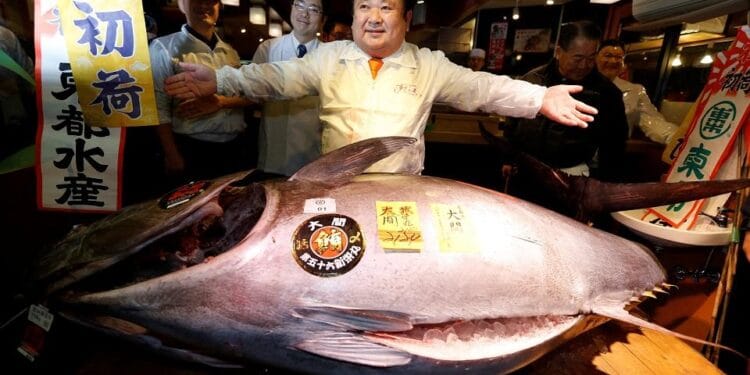No products in the cart.
The Bluefin Tuna: A High Commodity in Japan
Introduction: The Bluefin Tuna
Bluefin tuna holds a special place in Japanese culture and cuisine, revered not only for its flavor but also as a symbol of tradition and prestige. This fish’s significance goes beyond its culinary appeal, driving record-breaking auction prices and influencing global demand. In this blog, we’ll explore why bluefin tuna is such a prized commodity in Japan, its role in the economy, and the controversies surrounding its sustainability.
The Prestige of the New Year Tuna Auction
One of the most highly anticipated events in Japan’s fish markets is the New Year tuna auction, held annually at Tokyo’s Toyosu Market. This tradition, which dates back to the days of the Tsukiji Fish Market, has become a media spectacle. Restaurateurs and bidders compete for the honor of purchasing the first and often the most expensive tuna of the year.
Record-Breaking Prices
In 2023, the Onodera Group, a Michelin-starred sushi chain, made headlines by paying 207 million yen ($1.3 million) for a 276-kilogram bluefin tuna. This was the second-highest price ever recorded, following the 333.6 million yen ($3.1 million) paid in 2019 by Kiyoshi Kimura, the owner of Sushi Zanmai. Kimura, known as the “Tuna King,” has long used these auctions as a branding opportunity for his restaurant chain.
The staggering prices are not just about the fish itself. Winning the auction is seen as a way to bring good fortune for the year, gain media attention, and solidify one’s reputation in the competitive sushi industry. As Onodera official Shinji Nagao remarked, “The first tuna is something meant to bring in good fortune. Our wish is that people will eat this and have a wonderful year.”
Why Bluefin Tuna Is So Valued
Cultural and Culinary Importance
Bluefin tuna, known as maguro in Japanese, is the centerpiece of high-end sushi. Its fatty cuts, particularly otoro (the marbled belly), are considered a delicacy, prized for their rich texture and umami flavor. Sushi chefs in Japan treat bluefin with reverence, showcasing its versatility in various dishes.
Historically, tuna was not always a high-end fish. In the Edo period (1603–1868), it was considered a cheap source of protein. However, with the rise of sushi as a global cuisine, bluefin tuna became synonymous with luxury. Today, it is a must-have item in high-end sushi restaurants, both in Japan and worldwide.
Economic Impact
The bluefin tuna trade is a significant contributor to Japan’s economy. Japan consumes approximately **80% of the world’s bluefin tuna**, making it the largest market for this fish. The high demand supports numerous industries, including fishing, logistics, and hospitality.
The Role of Auctions in Marketing and Branding
A Lucrative Media Frenzy
Winning the New Year auction provides more than just bragging rights. The media frenzy that follows is a powerful marketing tool. Restaurants that secure these prized tuna often see a surge in customers eager to taste the “best tuna of the year.”
For instance, Sushi Zanmai experienced increased patronage after Kiyoshi Kimura’s record-breaking purchase in 2019. By associating his brand with the best tuna, Kimura reinforced his restaurant chain’s reputation for quality.
Symbolism and Tradition
In Japanese culture, the first sale of the year, or *hatsuseri*, holds symbolic significance. It is believed to set the tone for prosperity and success. This belief drives bidders to pay exorbitant prices, viewing the purchase as an investment in their business and a gesture of goodwill.

Challenges Facing the Bluefin Tuna Market
Overfishing and Sustainability
The global demand for bluefin tuna has led to overfishing, threatening the species’ survival. According to the International Union for Conservation of Nature (IUCN), Pacific bluefin tuna is classified as vulnerable, with its population at critically low levels in the past decade.
Efforts to regulate fishing include international agreements, such as quotas set by the Western and Central Pacific Fisheries Commission. Japan has also implemented measures to ensure sustainable fishing practices, but challenges remain.
Ethical Concerns
The extravagant prices paid at auctions have drawn criticism for promoting unsustainable consumption. Environmentalists argue that these events glorify excessive demand, making it difficult to curb overfishing.
During the COVID-19 pandemic, auction prices fell significantly due to reduced dining out, highlighting the fragility of this market and its dependence on luxury dining.
The Future of Bluefin Tuna in Japan
As concerns about sustainability grow, Japan faces a challenge: balancing its cultural traditions with the need to preserve bluefin tuna populations. Innovations in aquaculture, such as farm-raised bluefin, offer a potential solution.
Farm-Raised Bluefin
Japanese companies like Kindai University have pioneered the farming of bluefin tuna, producing fish entirely in captivity. This method reduces pressure on wild populations and ensures a steady supply for the market. However, farmed tuna comes with its own set of challenges, including high production costs and environmental impact.
Raising Awareness
Consumer education is crucial. By promoting sustainable choices and showcasing alternative seafood options, the industry can reduce its reliance on overfished species. Programs like the Marine Stewardship Council (MSC) certification encourage businesses to adopt sustainable practices.
Conclusion: A Delicate Balancing Act
Bluefin tuna’s status as a high commodity in Japan is deeply rooted in cultural, economic, and culinary traditions. The New Year auctions, with their eye-popping prices, symbolize more than just a fish sale—they represent prosperity, prestige, and the enduring appeal of Japanese cuisine.
However, as the global spotlight on sustainability intensifies, Japan must navigate a delicate balance between preserving its traditions and ensuring the future of bluefin tuna. By embracing innovation and responsible consumption, the country can continue to celebrate this iconic fish without compromising its survival.










